Breed of the Month – The Sphynx Cat
[ad#Commission Junction Petscriptions]
THE SPHYNX CAT
Origin
The Sphynx is a rare breed of cat known for its lack of a coat and is the oldest of the World’s three hairless breeds of cats. (2) Hairless cats have occurred now and again throughout history. (5) Hairlessness in cats is caused by a specific recessive gene, which means that the parents of a hairless cat must each carry a copy of the gene that they then pass down to their offspring. Unless genetically hairless cats are bred with either close relatives or other carriers of the gene, hairless cats would remain a rare occurrence. Some say that the gene that causes the Sphynx hairlessness might be produced by an offshoot of the same gene that produces the Devon Rex. However a different genetic symbol (hr) is given to the Sphynx gene and it is more likely that these are different genes. (1)
The Sphynx cat (or Canadian Sphynx, distinct from the Russian Sphynx breeds) originated in 1966, in Toronto Canada, when a hairless kitten named Prune was born of Domestic parents. (1)(2) The kitten was crossed with its mother, producing one more naked kitten. During the 1970’s several more hairless cats were born. (5) The first Sphynx breeders faced a number of problems trying to increase the numbers of Sphynx cats, as the genetic pool was very limited and thus many kittens died. In the early stages they tried crossing the Sphynx with the Devon-Rex to widen the gene pool, but later this crossing was stopped because it caused health problems. Cat breeders then bred the Sphynx to normal coated cats and then back to hairless cats for more than thirty years in order to create a genetically sound cat with a large gene pool and hybrid vigor and created today’s very robust breed with few problems. (3) After originating in Canada, the breed moved to the Netherlands and was developed in Europe. (5)(2) They are now bred in many countries & shown in many associations today. (2) If you decide you’d like to own a Sphynx, you may have to wait as they are rare, and most breeders have waiting lists. (4)(3)
Appearance
The Sphynx is a medium sized cat of normal proprotions with a rounded, full belly, broad, round chest, sturdy boning, and good musculature. (1)(4) A Sphynx cat typically has a narrow, wedge-shaped head, with oversized ears, (6) and pixiesh expression, (4) giving it a bat like look. (2) As they lack fur their ears are more pronounced and their tail is often described as a rats tail.(5) The legs are long, ending in long, agile toes with paw pads that are thicker than usual. The skin is wrinkled, feels chamois-like, & very warm to the touch. (2) Sphynxes have wedge-shaped heads, an open-eyed, intelligent face with a friendly expression. (3) and sturdy, heavy bodies. Adult males are larger than females. (3) The back is slightly arched and they tend to develop pot bellies as they age. (4)(7)
Though many people classify the Sphynx as a hairless cat, it is not truly without fur. Their coat is very fine as to be almost lacking. The coat resembles fine down and feels suede-like to the touch. (4) The skin of a Sphynx cat is covered with fine, soft fur, often likened to peach fuzz. Some light hair is often present on the nose, tail and toes. (1) Since the Sphynx cat doesn’t have a full coat of fur to keep itself warm, it tends to seek out the warmth of its owners. Because of this, the Sphynx cat is known as being a very affectionate breed.(6) Sphynx cats’ skin can also be wrinkly, like that of Chinese Shar Pei dogs but without fur to ameliorate the degree of wrinkliness. Their skin has a texture similar to a suede covered hot water bottle or a heated chamois. (3) Sphynx cats can be exceptionally cute – especially as kittens. The younger they are, the rounder their features and the more wrinkly their skin. (7) Lack of coat makes the cat quite warm to the touch.
Sphynx are acceptable in every color imaginable, and the color is seen in the pigment of the skin, as well as the few hairs they have.(4) All colors and patterns are possible and may be presented at any stage of maturity. The color is seen in the pigment of the skin and the few hairs that they do have. (3) Whiskers and eyebrows may be present, either whole or broken, or may be totally absent. They come in all the usual colour varieties including, tortoiseshell, chocolate, black, blue, lilac, chocolate etc.(5) The skin is the color their fur would be, and all the usual cat marking patterns (solid, point, van, tabby, tortie, etc) may be found on Sphynx skin. They can also have points, like Siamese cats do. (2)
Behaviour
Sphynxes are known for their lively, friendly, extravert behavior. (2)(1)(4) They are highly energetic, intelligent and affectionate towards their owners and (1) fit well into active, multi-pet, family households. (2) The Sphynx cats are alert and extremely inquisitive and love to be the center of attention. (2)(3) They perform silly antics for your entertainment and make great show cats because of this and they are easy for judges to handle. They prefer human attention but enjoy the company of dogs and other cats. (3) They crave human attention and are thus not suited to people wanting a quiet docile cat. Sphynx are very intelligent and can be taught to walk on a lead and respond to voice commands. (5)
Care
While Sphynx cats lack a coat to shed or groom, they are not maintenance-free. Body oils, which would normally be absorbed by the hair, tend to build up on the skin. Thus, regular cleaning or bathing is necessary; one bath a week is usually sufficient. Periodic bathing and ear cleaning is not a difficult task with a cat that has been acclimatised from kittenhood to it. (3) The ears need to be cleaned weekly with a q-tip and the nails need to be wiped weekly with a rag or baby wipe, due to the same oily secretions. (2) In addition to this, it is also very important to take good care of your Sphynx cat’s eyes and ears. Because of this breed’s lack of eyelashes, they may develop accumulated dust in their eye region, resulting in excessive discharge. Use a damp cloth to keep the Sphynx cat’s eyes clean. You can also use a commercial ear cleanser to clean their ears. Their ears should be cleaned once per week, in order to avoid excessive earwax buildup. (6)
Care should be taken to limit the Sphynx cat’s exposure to outdoor sunlight at length, as they can develop sunburn, photo damage and even skin cancer as they have nothing to protect their skin. In general, in cold weather, Sphynx cats should never be allowed outdoors unattended, as they struggle to conserve body heat in the cold. Their curious nature can also take them into dangerous places or situations, thus it is better for them to be indoor pets. (1)
Although Sphynx cats are sometimes thought to be hypoallergenic due to their lack of coat, this is not always the case . Allergies to cats are triggered by a protein called Fel d1, not cat hair itself. Fel d1 is a tiny and sticky protein primarily found in cat saliva and sebaceous glands causing people with cat allergies to sometimes react worse to direct contact with Sphynx cats than other breeds. However, some “cat allergic” people can successfully tolerate a Sphynx cat. (1)(3)
The Sphynx cats eat a bit more than most cats because their metabolism is high to maintain body heat. (5)(6) They are not finicky eaters & will do well on most premium cat foods. The Sphynx are adaptable to most households, most pets & most climates as long as affection, consideration& indoor care are provided. They are generally healthy & happy as long as their needs are met in a reasonable manner. The Sphynx also may require extra heating during the colder months. This can usually be achieved through the use of heat mat (depending on your temperature extremes). (5)
In addition to this, you should always provide your Sphynx cat with an ample supply of fresh water. (6) Sphynx cats are very conscious of their appearance, and have a natural love for personal hygiene. As such, it is very important that you keep your Sphynx cat’s litter box as clean as possible. Try to scoop up any excess waste on a daily basis, and be sure to completely replace your cat’s litter at least once per week. (6)
Health
The Canadian Sphynx is a healthy robust breed. Lack of hair can cause health issues with kittens in the first weeks of life due to susceptibility to respiratory infections. Reputable breeders will not let their kittens go to new homes without being at least 12 weeks of age to ensure the kitten is mature enough to cope in a new environment.
Hypertrophic cardiomyopathy is sometimes seen due to early outcrossing with Devon Rex and American Shorthair breeds. Studies are being undertaken to understand the links in breeding and the disorder. Sphynx cats can catch common feline diseases and should be immunized in the same way as other breeds. This breed of cat is prone to becoming overweight, primarily around their stomach region. (6)
Many thanks to Sue Eddey for her Stunning photographs of her cats!
References
1. http://en.wikipedia.org/wiki/Sphynx_%28cat%29
2. http://www.kittycat.co.za/Sphynx_profile.asp
3. http://www.cfainc.org/breeds/profiles/sphynx.html
4.http://cats.about.com/cs/breedprofiles/p/sphynx.htm
5. http://www.catsofaustralia.com/sphynx-catbreed-profile.htm
6.http://petcareeducation.com/cat/sphynx-cat-care/
7.http://webecoist.com/2010/02/02/sphynx-cats-play-feline-skins-game-to-win/

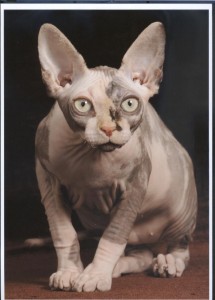
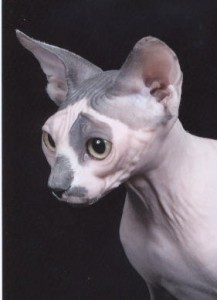
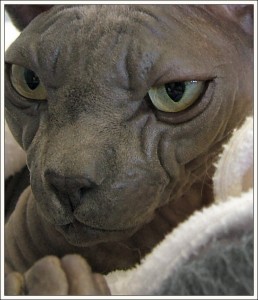
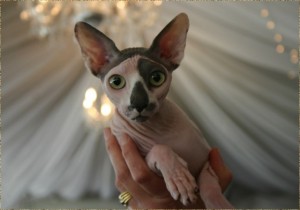
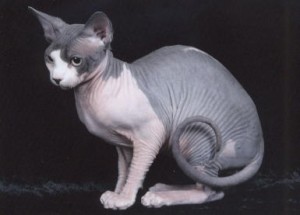
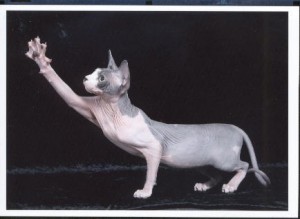
Leave a Reply
You must be logged in to post a comment.